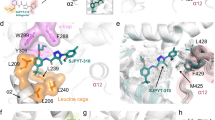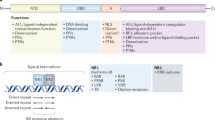Abstract
Crystal structure and co-regulator interaction studies have led to a general mechanistic view of the initial steps of nuclear receptor (NR) action. Agonist-induced transconformation of the ligand-binding domain (holo-LBD) leads to the formation of co-activator complexes, and destabilizes the co-repressor complexes bound to the ligand-free (apo) LBD1,2,3. However, the molecular basis of retinoid-X receptor (RXR) ‘subordination’ in heterodimers, an essential mechanism to avoid signalling pathway promiscuity, has remained elusive. RXR, in contrast to its heterodimer partner, cannot autonomously induce transcription on binding of cognate agonists4,5,6,7. Here we show that RXR can bind ligand and recruit co-activators as a heterodimer with apo-retinoic-acid receptor (apo-RAR). However, in the usual cellular environment co-repressors do not dissociate and they prohibit co-activator access because co-regulator binding is mutually exclusive. Accordingly, RXR subordination can be overcome in heterodimers that bind co-repressor weakly or in cells with a high co-activator content. We identify two types of RAR antagonists that differentially modulate co-regulator interaction, and we demonstrate that synergy between RAR ligands and RXR agonists6,8 results from increased interaction efficiency of a single p160 with the heterodimer, requiring two intact receptor-binding surfaces on the co-activator.
This is a preview of subscription content, access via your institution
Access options
Subscribe to this journal
Receive 51 print issues and online access
$199.00 per year
only $3.90 per issue
Buy this article
- Purchase on SpringerLink
- Instant access to full article PDF
Prices may be subject to local taxes which are calculated during checkout




Similar content being viewed by others
References
Bourguet, W., Germain, P. & Gronemeyer, H. Nuclear receptor ligand-binding domains: three-dimensional structures, molecular interactions and pharmacological implications. Trends Pharmacol. Sci. 21, 381–388 (2000).
Glass, C. K. & Rosenfeld, M. G. The coregulator exchange in transcriptional functions of nuclear receptors. Genes Dev. 14, 121–141 (2000).
Freedman, L. P. Increasing the complexity of coactivation in nuclear receptor signaling. Cell 97, 5–8 (1999).
Kurokawa, R. et al. Regulation of retinoid signalling by receptor polarity and allosteric control of ligand binding. Nature 371, 528–531 (1994).
Forman, B. M., Umesono, K., Chen, J. & Evans, R. M. Unique response pathways are established by allosteric interactions among nuclear hormone receptors. Cell 81, 541–550 (1995).
Chen, J. Y. et al. Two distinct actions of retinoid-receptor ligands. Nature 382, 819–822 (1996).
Vivat, V. et al. A mutation mimicking ligand-induced conformational change yields a constitutive RXR that senses allosteric effects in heterodimers. EMBO J. 16, 5697–5709 (1997).
Roy, B., Taneja, R. & Chambon, P. Synergistic activation of retinoic acid (RA)-responsive genes and induction of embryonal carcinoma cell differentiation by an RA receptor alpha (RARα)-, RARβ-, or RARγ-selective ligand in combination with a retinoid X receptor-specific ligand. Mol. Cell. Biol. 15, 6481–6487 (1995).
Voegel, J. J. et al. The coactivator TIF2 contains three nuclear receptor-binding motifs and mediates transactivation through CBP binding-dependent and -independent pathways. EMBO J. 17, 507–519 (1998).
Lehmann, J. M. et al. Retinoids selective for retinoid X receptor response pathways. Science 258, 1944–1946 (1992).
Voegel, J. J., Heine, M. J. S., Zechel, C., Chambon, P. & Gronemeyer, H. TIF2, a 160 kDa transcriptional mediator for the ligand-dependent activation function AF-2 of nuclear receptors. EMBO J. 15, 3667–3675 (1996).
Westin, S. et al. Interactions controlling the assembly of nuclear-receptor heterodimers and co-activators. Nature 395, 199–202 (1998).
Klein, E. S. et al. Identification and functional separation of retinoic acid receptor neutral antagonists and inverse agonists. J. Biol. Chem. 271, 22692–22696 (1996).
Chen, J. D. & Evans, R. M. A transcriptional co-repressor that interacts with nuclear hormone receptors. Nature 377, 454–457 (1995).
Hu, X. & Lazar, M. A. The CoRNR motif controls the recruitment of corepressors by nuclear hormone receptors. Nature 402, 93–96 (1999).
Nagy, L. et al. Mechanism of corepressor binding and release from nuclear hormone receptors. Genes Dev. 13, 3209–3216 (1999).
Perissi, V. et al. Molecular determinants of nuclear receptor-corepressor interaction. Genes Dev. 13, 3198–3208 (1999).
Hu, X., Li, Y. & Lazar, M. A. Determinants of CoRNR-dependent repression complex assembly on nuclear hormone receptors. Mol. Cell. Biol. 21, 1747–1758 (2001).
Cohen, R. N. et al. The specificity of interactions between nuclear hormone receptors and corepressors is mediated by distinct amino acid sequences within the interacting domains. Mol. Endocrinol. 15, 1049–1061 (2001).
Wong, C. W. & Privalsky, M. L. Transcriptional silencing is defined by isoform- and heterodimer-specific interactions between nuclear hormone receptors and corepressors. Mol. Cell. Biol. 18, 5724–5733 (1998).
Bourguet, W. et al. Crystal structure of a heterodimeric complex of RAR and RXR ligand-binding domains. Mol. Cell 5, 289–298 (2000).
Yang, W., Rachez, C. & Freedman, L. P. Discrete roles for peroxisome proliferator-activated receptor gamma and retinoid X receptor in recruiting nuclear receptor coactivators. Mol. Cell. Biol. 20, 8008–8017 (2000).
Hittelman, A. B., Burakov, D., Iniguez-Lluhi, J. A., Freedman, L. P. & Garabedian, M. J. Differential regulation of glucocorticoid receptor transcriptional activation via AF-1-associated proteins. EMBO J. 18, 5380–5388 (1999).
Benecke, A., Chambon, P. & Gronemeyer, H. Synergy between estrogen receptor a activation functions AF1 and AF2 mediated by transcription intermediary factor TIF2. EMBO Rep. 1, 151–157 (2000).
Alen, P., Claessens, F., Verhoeven, G., Rombauts, W. & Peeters, B. The androgen receptor amino-terminal domain plays a key role in p160 coactivator-stimulated gene transcription. Mol. Cell. Biol. 19, 6085–6097 (1999).
Yang, W. & Freedman, L. P. 20-Epi analogues of 1,25-dihydroxyvitamin D3 are highly potent inducers of DRIP coactivator complex binding to the vitamin D3 receptor. J. Biol. Chem. 274, 16838–16845 (1999).
Nagpal, S., Friant, S., Nakshatri, H. & Chambon, P. RARs and RXRs: evidence for two autonomous transactivation functions (AF-1 and AF-2) and heterodimerization in vivo. EMBO J. 12, 2349–2360 (1993).
Iyer, J. et al. Versatile copurification procedure for rapid isolation of homogeneous RAR-RXR heterodimers. Protein Expr. Purif. 16, 308–314 (1999).
Bourguet, W. et al. Heterodimeric complex of RAR and RXR nuclear receptor ligand-binding domains: purification, crystallization, and preliminary X-ray diffraction analysis. Protein Expr. Purif. 19, 284–288 (2000).
Chen, J. et al. RAR-specific agonist antagonists which dissociate transactivation and AP1 transrepression inhibit anchorage-independent cell proliferation. EMBO J. 14, 1187–1197 (1995).
Acknowledgements
We thank W. Raffelsberger for providing the PCR protocols for RARβ2 promoter amplification, and N. Potier and A. van Dorsselaer for the ESI-MS analysis. We are grateful to C. Peluso-Iltis and V. Chavant for help in protein purification, C. Erb for expression vectors and A. Pornon for technical assistance. We thank W. Bourguet for critically reading this manuscript and Y. Lutz and C. Egly for antibodies. BMS-labelled retinoids/rexinoids were provided by C. Zusi, and CD3254 and AGN192870 by U. Reichert and S. Michel. This work was supported by the Institut National de la Santé et de la Recherche Médicale, the Centre National de La Recherche Scientifique, the Hôpital Universitaire de Strasbourg, the European Community and Bristol-Myers Squibb.
Author information
Authors and Affiliations
Corresponding author
Ethics declarations
Competing interests
The authors declare no competing financial interests.
Rights and permissions
About this article
Cite this article
Germain, P., Iyer, J., Zechel, C. et al. Co-regulator recruitment and the mechanism of retinoic acid receptor synergy. Nature 415, 187–192 (2002). https://doi.org/10.1038/415187a
Received:
Accepted:
Issue Date:
DOI: https://doi.org/10.1038/415187a



